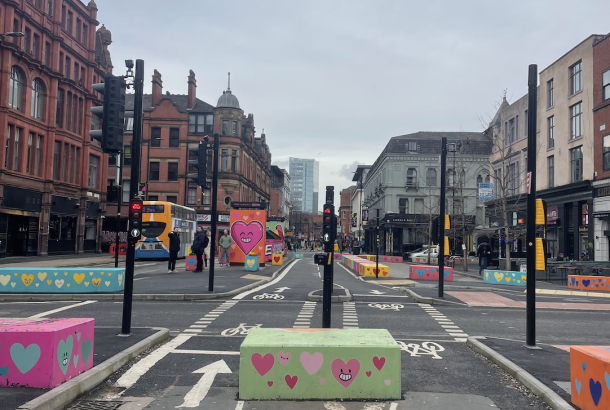Cyclists face danger on Oxford Road corridor
By Ben Flanagan
The tragic death of 21 year-old student Joshua Jarvis last week highlights the real dangers cyclists face when using the Oxford Road corridor.
Joshua, who studied film production at MMU and lived in Fallowfield, was pronounced dead at the scene following a serious collision with a cement mixer. The incident occurred Tuesday, February 11th at the junction of Wilmslow Road and Landcross Road, close to the Owens Park halls of residence. His death demonstrates the clear dangers that cyclists face each time they use the route, and Manchester’s road network in general.
A recent report by the Manchester Evening News named Wilmslow Road the most dangerous route in the city for cyclists. Accident data gained from the Department for Transport shows that from 2005-2012 there were 162 reported collisions along the corridor, 67 of which occurred near the Curry Mile. This is more than any other route in the city.
Over 2000 cyclists are thought to use the corridor on a daily basis. The route, which encompasses Oxford Street, Oxford Road and Wilmslow Road, is used by many students who reside in Fallowfield and its surrounding areas, as part of their commute to the three universities’ along Oxford Road.
While there is a cycle lane along the entire corridor, with a segregated traffic-free lane near Whitworth Park, many cyclists are still involved in collisions. The cause of these accidents and who is to blame is an area of great debate within the wider cycling community.
Former president of the University’s cycling club, Rachel Murray is a regular commuter along the corridor and she suggested that cyclists’ behaviour might be to blame.
“The number of un-helmeted students that jump lights at crossroads without any lights on their bike is uncountable. Daily, I see riders undertake [vehicles] at inappropriate times and get themselves into bother”
While riding without a helmet is currently not against the law in the UK, running red traffic lights and riding without lights in times of darkness are.
Murray’s opinion is one shared with that of Greater Manchester Police, who launched a crackdown on cycle related offences at the beginning of 2013, in a bid to encourage cyclists to learn how to share the road safely with others. Operation Grimaldi mainly focuses on ‘hot spot’ areas where there are high rates of cycle related accidents, while also looking at areas where pedal cyclists have been seen to be using the roads dangerously or irresponsibly. Unsurprisingly this has led to the team working mainly along the Oxford and Wilmslow road.
Early in the New Year I was invited to observe the Grimaldi team during an operation at the junction of Platt Lane and Wilmslow Road. Offenders, who had been stopped for offences such as running red lights, not having lights fitted, cycling on footpaths and using mobile phones whilst cycling, were issued with a £50 fixed penalty notice, with the option to have the fine quashed if they attended a cycle safety awareness course. The team not only targeted cyclists but also stopped motorists for offences including not wearing a seatbelt and running a red light.
Last year 400 cyclists were issued with fines in just 10 days of the crackdown, with 85% of offender’s opting for the cycling safety awareness course.
PCSO Gareth Walker who is heavily involved with operation Grimaldi said, “The aim of the operation was not to fine all offenders but to educate them, offer training and promote road safety. Many of the cyclists we spoke to were not aware of the danger they put themselves and others in by the actions they were taking while failing to stop or being distracted on their phones. The number of people killed or seriously injured on the roads has fallen over the last two years but we need to continue to educate road users of how to share the roads safely in order to ensure these numbers continue to fall.”
However are cyclists totally to blame for collisions? Not so, says cyclist Martin Mayor.
“Cyclists don’t kill people, drivers do,” said Mr Mayor, speaking to the Mancunion last year. “Really, cyclists cause very few accidents. It is a fact that the fault lies with the drivers.” He added, “Cyclists that are killed can’t actually ever give their side of the story.”
Rachel Murray also questioned the driving habits of motorists along the road. “Drivers in Rusholme are amongst the worst I’ve ever seen and that particular stretch of road would warrant some attention”.
Whether the blame falls with the motorist or cyclist, in almost all cases it is the cyclist who loses out as they are the most vulnerable road user and not being as protected as the motorist, who is surrounded by a relatively solid metal bubble. Thus, reducing the chance of a collision is crucial.
Currently Transport for Greater Manchester is beginning preliminary work on a bus priority scheme along Oxford Road, which will also benefit cyclists. The project, which has an expected completion date of summer 2015, will see a complete re-design of the corridor between Portland Street and Hathersage Road. The road will be limited to buses, bicycles, taxis and emergency vehicles. “Dutch-style” cycle lanes are also to be created which will allow cyclists to safely pass bus stops whilst remaining separate from the general traffic.
However while the project will see a large amount of investment into new infrastructure outside the universities, the scheme does not address the safety of cyclists along the Curry Mile and Wilmslow Road, the hot spot for cycle related accidents.
As the majority of cycling accidents occur in close proximity to junctions along the corridor, measures to protect cyclists at these “black spots” have been suggested.
New low-level traffic lights are currently being developed by Transport for London, in an attempt to reduce the risk of collision at junctions by giving cyclists an early start over other road users. Trials of the new lights began earlier this month with the lights due to be installed at 5 key junctions in the capital.
Advanced stop lines also give cyclists priority over other traffic as the zone allows cyclists to position themselves in front of other traffic, while also reducing the amount of exhaust fumes they are breathing in. However there are currently no laws preventing motor vehicles entering the advanced stop zone while waiting at a red light.
HGV’s and buses are well known to have considerable blind spots, therefore when turning cannot see cyclists who are coming up their nearside. Convex ‘Trixi’ mirrors fixed to traffic lights help HGV drivers to see better and reduces their blind spot, thus making the chance of a collision smaller. 176 mirrors are due to be installed across Greater Manchester at key left hand turns.
Speaking to the Manchester Evening News, Eleanor Roaf, regional director for the cycling charity Sustrans said, “by increasing the visibility of cyclists while also giving them priority at junctions the chance of an incident occurring between a cyclists and motorist is significantly reduced”.
She added “The safer we make our roads, the more people are encouraged to travel by bike and that makes for healthier, cleaner and more prosperous Greater Manchester”.







